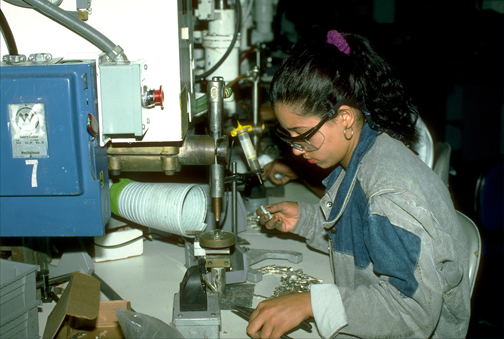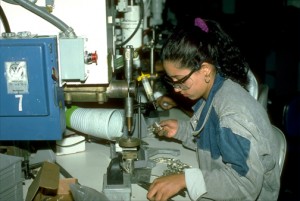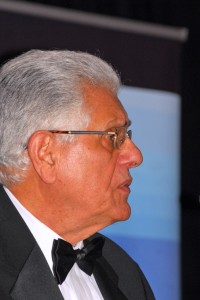D.C.-area Hispanic group honors Dominican diplomat


“Twin plants” — which took advantage of low-wage Dominican labor and Puerto Rico’s 936 program— generated $750 million in investments and resulted in the creation of 220,000 jobs across the Dominican Republic. (Credit: Larry Luxner)
WASHINGTON — Veteran Dominican diplomat Roberto B. Saladín, an early champion of the “twin plant” program that for years linked the Dominican Republic and Puerto Rico economically, accepted a public service award Friday night from the Greater Washington Hispanic Chamber of Commerce.
Saladín, 76, is his country’s permanent representative to the Organization of American States, though he’s been ambassador to the United States on two previous occasions (1999-2002 and 2009-11) and has also represented the Dominican Republic at the Inter-American Development Bank.
“For me, it is a great honor to receive this award, which recognizes Hispanic leaders and diplomats from Latin America for their contribution to regional development of our economies and the growth of trade among our nations,” Saladín told about 90 fellow diplomats, community leaders and others at the historic Carnegie Library on Mt. Vernon Square for GWHCC’s Fourth Annual Embassy Celebration.
Previous recipients of the GWHCC’s Public Service Award are Ecuador’s former ambassador to the United States, Luís Gallegos (who was later declared persona non grata and expelled after Washington and Quito briefly downgraded diplomatic ties), as well as two members of Congress: Rep. Ileana Ros-Lehtinen (R-Florida), chair of the House Foreign Relations Committee, and Rep. Eliot Engel (D-New York), also a member of that committee.
‘Twin-plant’ program successful
In 1971, Saladín founded the Dominican Center for Promotion of Exports (known by its acronym CEDOPEX). Two decades later, that agency joined the Office of Investment Promotion (OPI) to form what’s now known as the Centro de Exportación e Inversión-Republica Dominicana (CEI-RD).
“The twin plant program was very useful, because U.S. corporations that operated in Puerto Rico were, according to Section 936 of the Internal Revenue Code, allowed to keep the profits of those corporations in Puerto Rico,” Saladín told NIMB. “After the creation of maquilas in the D.R., they decided to develop free-zone factories tied to apparel, shoes and other products.”
During that time, he said, these “twin plants” — which took advantage of low-wage Dominican labor and Puerto Rico’s 936 program— generated $750 million in investments and resulted in the creation of 220,000 jobs across the Dominican Republic.
All told, free zones at their peak employed close to 620,000 Dominicans, “reducing the pressure to migrate to the United States,” he said.
“Apart from the creation of jobs in the provinces, 67 percent of the labor force in these plants were women. That was a very important social issue,” Saladín explained. “Then the multifiber agreement was phased out. Up to that moment, the Dominican Republic had been the second-largest exporter of textiles and apparel to the U.S. after China. Then, after the U.S., Mexico and Canada signed NAFTA, Mexico became the top producer in Latin America.”
Saladín is both an economist and a lawyer, and before being sent to Washington for the first time in October 1999, he was general manager and CEO of Banco de Reservas, one of his country’s largest banks.
Saladín’s resumé also includes stints as the Dominican Republic’s minister of finance (1986-87), governor of the Central Bank (1987-89) and president of the country’s monetary board.
As Santo Domingo’s envoy in Washington, he supported the Caribbean Basin Trade Promotion Authority Act — an extension of the Caribbean Basin Initiative, which was first passed in 1984. He also worked hard to incorporate the Dominican Republic into the Central American Free Trade Agreement, which was eventually ratified by all seven signatories as DR-CAFTA.
Some twin plants — known in Spanish as “plantas gemelas” — still remain in La Romana, but with Section 936 having been abolished by the Clinton administration in 1994, the focus has changed. No longer one of the world’s top apparel manufacturers, the Dominican Republic has instead become a leading exporter of shoes and medical equipment.
“The most important force for development in history is international trade. The import and export of manufactured goods has been, is and will remain the link that strengthens relations between countries,” said the diplomat. “The empirical evidence shows that countries open to commerce, without protectionist barriers, have a higher per-capita income in relation to their GDP than countries which maintain barriers to trade.”
Promoting foreign investment
These days, the CEI-RD is actively promoting U.S. and foreign investment in the Dominican Republic, particularly along the country’s frontier with Haiti. Some 6,000 people now work in a giant free zone in the Haitian town of Ouanaminthe, making blue jeans and other apparel for the U.S. market under preferential terms.
“For every two jobs created in Haiti, one is created in the D.R.,” he said.












